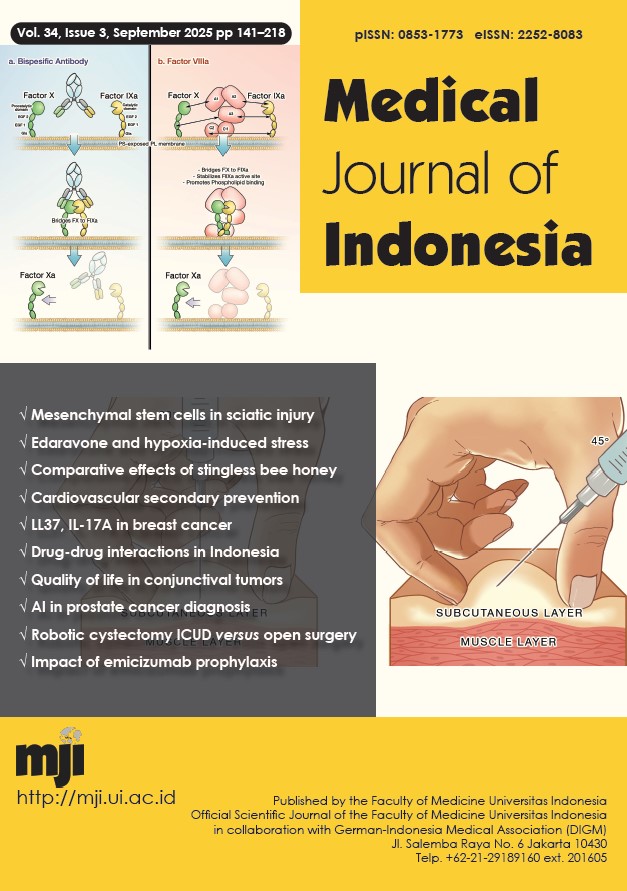Comparing suturing techniques and materials in hypospadias repair: a prospective cohort study
DOI:
https://doi.org/10.13181/mji.oa.257921Keywords:
hypospadias, sutures, suture techniques, urinary fistula, wound dehiscenceAbstract
BACKGROUND Various techniques are available for hypospadias surgery, but the most effective suturing techniques and suture materials remain debated. This study aimed to evaluate the outcomes of hypospadias repair using various suturing techniques and materials.
METHODS This prospective cohort study was conducted from August 2023 to August 2024 and included all patients who underwent hypospadias surgery at Cipto Mangunkusumo Hospital. We compared the outcomes of 2 suturing techniques (interrupted versus continuous) and 2 suture materials (6-0 polydioxanone [PDS] versus poliglecaprone 25) used for neourethra suturing. Follow-up assessments were conducted at 1, 2, and 4 weeks postoperatively, and subsequently every 3 to 6 months, focusing on complications.
RESULTS 162 participants were included, with a mean age of 6.27 (3.99) years and a mean follow-up period of 20.39 (14.25) weeks. Complications occurred in 31 patients (19.1%), with a significant association between hypospadias type and complication occurrence (p = 0.039). Complication rates were 9.4% in distal, 12.5% in midshaft, and 26.8% in proximal cases. No significant differences were found between suturing techniques (interrupted: 19% versus continuous: 12%, p = 0.429) or suture materials (6-0 PDS: 22% versus 6-0 poliglecaprone 25: 9%, p = 0.998). Subgroup analyses by hypospadias type also showed no significant differences by suture type or technique (all p>0.05), although a trend toward significance was noted in proximal cases (p = 0.062).
CONCLUSIONS The choice of suturing techniques and suture materials does not affect complication rates in hypospadias repair, allowing surgeons to decide based on personal expertise and preference.
Downloads
References
Halaseh SA, Halaseh S, Ashour M. Hypospadias: a comprehensive review including its embryology, etiology and surgical techniques. Cureus. 2022;14(7):e27544. https://doi.org/10.7759/cureus.27544
Wood D, Wilcox D. Hypospadias: lessons learned. An overview of incidence, epidemiology, surgery, research, complications, and outcomes. Int J Impot Res. 2023;35(1):61-6. https://doi.org/10.1038/s41443-022-00563-7
Gul M, Hildorf S, Silay MS. Sexual functions and fertility outcomes after hypospadias repair. Int J Impot Res. 2021;33(2):149-63. https://doi.org/10.1038/s41443-020-00377-5
Ceccarelli PL, Lucaccioni L, Poluzzi F, Bianchini A, Biondini D, Iughetti L, et al. Hypospadias: clinical approach, surgical technique and long-term outcome. BMC Pediatr. 2021;21(1):523. https://doi.org/10.1186/s12887-021-02941-4
Liao AY, Smith GH. Urethrocutaneous fistulae after hypospadias repair: when do they occur? J Paediatr Child Health. 2016;52(5):556-60. https://doi.org/10.1111/jpc.13102
Bostancı SA, Tiryaki HT. Urethracutaneous fistulas after hypospadias repair; evaluation of 34 cases. Pediatr Cerrahi Derg. 2019;33(2):060-4. https://doi.org/10.5222/JTAPS.2019.24572
Wu Y, Wang J, Zhao T, Wei Y, Han L, Liu X, et al. Complications following primary repair of non-proximal hypospadias in children: a systematic review and meta-analysis. Front Pediatr. 2020;8:579364. https://doi.org/10.3389/fped.2020.579364
Gupta A, Gupta R, Srivastav P, Gupta A. Comparison of interrupted- and continuous-suture urethroplasty in tubularised incised-plate hypospadias repair: a prospective study. Arab J Urol. 2017;15(4):312−8. https://doi.org/10.1016/j.aju.2017.10.004
Shirazi M, Haghpanah A, Dehghani A, Haghpanah S, Ghahartars M, Rahmanian M. Comparison of post-urethroplasty complication rates in pediatric cases with hypospadias using Vicryl or polydioxanone sutures. Asian J Urol. 2022;9(2):165−9. https://doi.org/10.1016/j.ajur.2021.08.010
Andersson M, Doroszkiewicz M, Arfwidsson C, Abrahamsson K, Sillén U, Holmdahl G. Normalized urinary flow at puberty after tubularized incised plate urethroplasty for hypospadias in childhood. J Urol. 2015;194(5):1407-13. https://doi.org/10.1016/j.juro.2015.06.072
Rynja SP, de Jong TP, Bosch JL, de Kort LM. Functional, cosmetic and psychosexual results in adult men who underwent hypospadias correction in childhood. J Pediatr Urol. 2011;7(5):504-15. https://doi.org/10.1016/j.jpurol.2011.02.008
Widjajana DP, Wahyudi SS, Sutejo IR. The relation of hypospadias types, ages, and surgical techniques for urethrocutaneous fistula complication in child hypospadias cases. JURI. 2019;26(2). https://doi.org/10.32421/juri.v26i2.451
Ulman I, Erikçi V, Avanoğlu A, Gökdemir A. The effect of suturing technique and material on complication rate following hypospadias repair. Eur J Pediatr Surg. 1997;7(3):156−7. https://doi.org/10.1055/s-2008-1071079
Samir M, Mahmoud MA, Azazy S, Tawfick A. Does the suturing technique (continuous versus interrupted) have an impact on the outcome of tubularized incised plate in hypospadias repair with adequate urethral plate? A prospective randomized study. J Pediatr Urol. 2021;17(4):519.e1−7. https://doi.org/10.1016/j.jpurol.2021.04.021
Sarhan O, Saad M, Helmy T, Hafez A. Effect of suturing technique and urethral plate characteristics on complication rate following hypospadias repair: a prospective randomized study. J Urol. 2009;182(2):682−5. https://doi.org/10.1016/j.juro.2009.04.034
Borkar N, Tiwari C, Mohanty D, Singh S, Dhua A. The comparison of interrupted and continuous suturing technique in snodgrass urethroplasty in patients with primary hypospadias: a systematic review and meta-analysis. Urol Ann. 2023;15(1):74−81. https://doi.org/10.4103/ua.ua_100_22
Subihardi LM, Yatindra IB, Rahman LA, Setiawan MR, Andhika DP, Soebadi MA. A thorough analysis of the effects and complications of two different suturing techniques in hypospadias repair using tubularized-incised plate urethroplasty: a meta-analysis. Med Arch. 2023;77(3):194-201. https://doi.org/10.5455/medarh.2023.77.194-201
Downloads
Published
How to Cite
Issue
Section
License
Copyright (c) 2025 Ebram Nainggolan, Putu Angga Risky Raharja, Gerhard Reinaldi Situmorang, Arry Rodjani, Irfan Wahyudi

This work is licensed under a Creative Commons Attribution-NonCommercial 4.0 International License.
Authors who publish with Medical Journal of Indonesia agree to the following terms:
- Authors retain copyright and grant Medical Journal of Indonesia right of first publication with the work simultaneously licensed under a Creative Commons Attribution-NonCommercial License that allows others to remix, adapt, build upon the work non-commercially with an acknowledgment of the work’s authorship and initial publication in Medical Journal of Indonesia.
- Authors are permitted to copy and redistribute the journal's published version of the work non-commercially (e.g., post it to an institutional repository or publish it in a book), with an acknowledgment of its initial publication in Medical Journal of Indonesia.





































